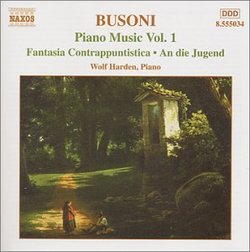| All Artists: Ferruccio Busoni, Wolf Harden Title: Busoni: Piano Music, Vol. 1 Members Wishing: 0 Total Copies: 0 Label: Naxos Release Date: 5/15/2001 Genre: Classical Styles: Chamber Music, Forms & Genres, Fantasies, Historical Periods, Classical (c.1770-1830) Number of Discs: 1 SwapaCD Credits: 1 UPC: 747313503421 |
Search - Ferruccio Busoni, Wolf Harden :: Busoni: Piano Music, Vol. 1
 | Ferruccio Busoni, Wolf Harden Busoni: Piano Music, Vol. 1 Genre: Classical
|
Larger Image |
CD Details |
CD Reviews"To Godowsky the piano was the thing; to Busoni, the idea" Hexameron | 07/20/2007 (5 out of 5 stars) "Ferruccio Busoni (1866-1924) was universally appreciated as a genius with the piano. His style of playing and the ideas he developed in his compositions enable him to stand shoulder-to-shoulder with Godowsky as a transcendental composer. Harold Schonberg proclaimed: "To Godowsky the piano was the thing; to Busoni, the idea." Yet today the name of "Busoni" is too often linked, literally by a hyphen, with "Bach," owing to the many transcriptions Busoni crafted. There are countless recordings of these Bach transcriptions, but few actual volumes exist that explore Busoni's original music. Naxos has fixed this, and with the talents of Wolf Harden, Busoni's piano works have a new and worthy champion.
Bach's "Toccata and Fugue in D minor" has been transcribed dozens of times by third-rate publishers and first-rate composers; Tausig, Reger, Friedman, and Grainger stand out from the rest. Busoni's treatment, however, is simply magnificent. The sublime melodic material of the toccata is what makes it a classic, and Busoni's extrovert transcription is thrilling, especially in the hands of the muscular Harden. While Busoni adheres faithfully to Bach's score and polyphonic writing, one can expect the usual pianistic reworking of octave-doublings and thicker textures, all in the service of increasing organ-like sonority. Busoni's early "Prelude and Fugue in C minor" shows influence from Bach and Busoni's contrapuntal mastery is ravishing. Harden plays the Prelude beautifully and suggests deep introspection, while the Fugue, for all its brevity, becomes magisterial. The epic works that represent the body of this recording are "An die Jugend" and the "Fantasia Contrappuntistica." Busoni's awe-inspiring intellect and compositional individuality streams through in "An die Jugend," where, as Richard Whitehouse, the liner-notes writer observes, "transcription and composition merge in a synthesis of past and present..." The first "Preludietto" shows clever innovations with its "classical A major in the left-hand and a whole-tone Impressionism in the right hand." The fourth "Pagininesco" is the most profound of the set, fusing the aesthetic of Liszt with Busoni's temperament in dealing with Paganini's Eleventh caprice. In the fifth of the set, "Epilogo," Busoni embarks on a modulatory journey, and then through a whole-tone scale enters into atonality, effectively demonstrating "the development from Classical Tonality, through Free Tonality, to New Tonality." Busoni's magnum opus is surely the great "Fantasia Contrappuntistica." While Busoni was working on his own edition of Bach's music, he had an idea to use one of Bach's unfinished fugue subjects from the "Art of Fugue" (Contrapunctus XIX). In addition to working with this he also used the Bach chorale, "Allein Gott in der Hoeh sei Ehr," but it is overwhelmingly more complicated than this. In six significant "movements" of this 30 minute polyphonic tapestry, Busoni takes the listener on an incredibly difficult but utterly magical voyage. Kenneth Derus has made an interesting analysis of this work and points out that some have called this towering composition "literally 'unhearable,' except perhaps by professional musicians armed with annotated scores." Having been acquainted with John Ogdon's performance of this, I knew what to expect: all-encompassing tonality, busy polyphonic writing, symmetrical inversions and complex treatment of fugue subjects. Harden actually surprised me in this work. He projects crystalline and dynamic clarity, and thus allows this cerebral mammoth to breathe. Harden can also boast absolute emotional and mental endurance, as in the Stretta, where he unfurls climactic power and velocity. For those new to this music, be forewarned that it takes many hearings to appreciate its complexities, and yet I think it has the power to be gripping on a single listening. Bottom line: Busoni compresses a wealth of ideas into every page of his compositions. There is music here that could keep a music theorist busy for years and music lovers contented for decades. Some of Busoni's most highly original works can be found in this Volume. The treasure trove of "An die Jugend" speaks for itself, while the "Fantasia Contrappuntistica" is a phenomenal document of contrapuntal ingenuity and intellectual strength. Wolf Harden joins the small list of performers able to not only cope with the technical demands, but also deliver the full gamut of expression behind Busoni's labyrinthine work." |

 Track Listings (13) - Disc #1
Track Listings (13) - Disc #1